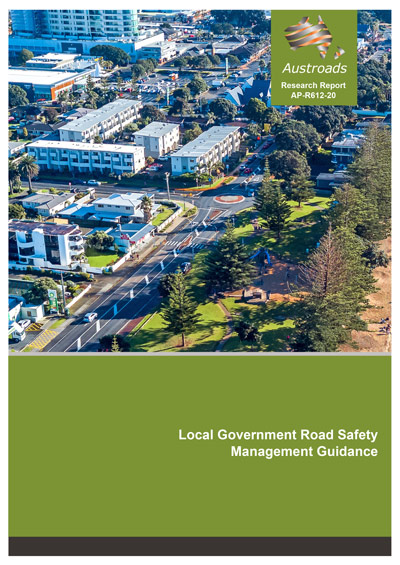Road Safety

- Publication no: AP-R612-20
- ISBN: 978-1-925854-72-5
- Published: 22 January 2020
- PDF (free) Download
This guidance is designed to provide contemporary best practice methods on the development and implementation road safety management frameworks suitable for use in a local government context.
The type of roads managed by local government means that safety issues are different in nature and spatial distribution than on state roads. Local government roads typically have lower traffic volumes, more dispersed crashes, a wider variety of road environments and a greater mix of road users, all of which make managing road safety on local government roads an especially challenging task.
The guidance introduces functions necessary for the implementation of a road safety management system and describes key principles such as strategic partnerships, shared responsibilities, capacity building, program development and delivery and funding.
- Summary
- 1. Introduction
- 1.1 Purpose
- 1.2 Need for Separate Guidance for Local Government
- 1.3 Strategic Role of Local Government
- 1.4 Role of Local Government in Road Safety
- 2. The Road Safety Management System
- 2.1 International Context
- 2.2 The Safe System Approach
- 2.2.1 Role of Speed in the Safe System
- 2.3 Systematic View of Road Safety Management
- 2.4 National Road Safety Strategies
- 2.4.1 New Zealand
- 2.4.2 Australia
- 2.5 Relevance for Local Government
- 3. Developing a Framework for Road Safety Management
- 3.1 Background
- 3.2 Getting Started
- 3.3 Commitment and Leadership
- 3.4 Character and Benefits
- 3.4.1 Road Safety Management Systems
- 3.4.2 Road Safety Management Plans
- 3.5 Development Processes
- 3.5.1 Top Down Approach
- 3.5.2 Bottom Up Approach
- 3.6 Guiding Principles
- 3.7 Safety Performance Indicators
- 3.8 Problem Analysis
- 4. Developing Interventions for Local Government
- 4.1 Overview
- 4.2 Developing Safe Roads and Roadsides
- 4.2.1 Primary Treatments
- 4.2.2 Local Government Safety Treatments
- 4.3 Developing Safe Speeds
- 4.4 Developing Safe People
- 4.4.1 Workplace Health and Safety
- 4.5 Developing Safe Vehicles
- 4.6 Community Road Safety
- 5. Implementation
- 5.1 Strategic Partnerships
- 5.2 Shared Responsibilities from Safe System Philosophy
- 5.2.1 Who are the Stakeholders?
- 5.2.2 Coordination with the Lead Agency
- 5.3 Capacity Building and Resources
- 5.3.1 Capacity Building
- 5.3.2 Resources
- 5.4 Program Development and Delivery
- 5.5 Funding
- 6. Monitoring and Evaluation
- 6.1 Importance and Purpose
- 6.2 Evaluation Principles
- 6.3 Case Study
- 7. Useful Information Sources
- National strategies
- State and territory strategies
- Mode specific strategies
- References
